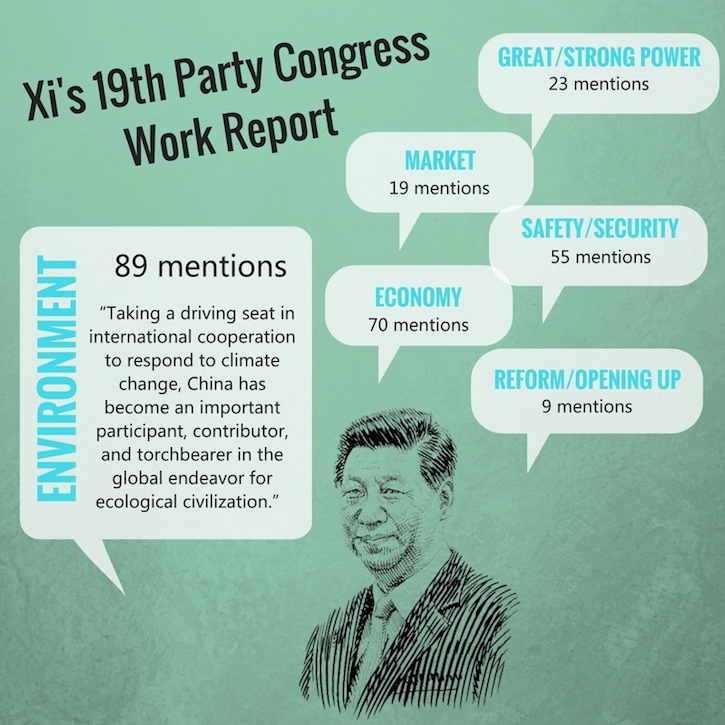By Phylicia Wu
The conclusion of China’s 19th Party Congress had a number of revelations—a new Party leadership without Wang Qishan or an apparent heir, a seemingly more powerful President Xi with his thought enshrined in the Party constitution, and yes, another Party work report albeit this iteration was delivered for over three hours. Traditionally, the Party work report provides a review of the accomplishments since the previous Congress and communicates an ideal blueprint for the next five years.
President Xi referenced the environment and related phrases, including green finance, more frequently than he did the economy in the work report. This is a significant shift from the previous laser-focus on GDP growth rates to an emphasis on sustainable growth for China’s future. In fact, Xi did not explicitly suggest a GDP target in the work report, which signals the Party is committed to greening development, but is consciously aware that green initiatives may have an economic dampening effect in the short term. However, this shift in the work report is a harbinger of China’s intent in Xi’s second term.
According to the work plan, China made great strides during the past five years and renewed its commitment to green development for the five years to follow. Known as the world’s largest greenhouse gas emitter, China recognizes that addressing environmental concerns is long overdue. Since the 18th Party Congress emphasis placed on “ecological civilization,” green development has become a growing imperative. As Xi noted in his speech, “We have made notable progress in building an ecological civilization,” and China has by reducing coal overcapacity, promoting the development of new energy vehicles, and issuing the world’s largest number of green bonds.

China’s efforts in the next five years will likely attempt to substantiate Xi’s remarks at Davos earlier this year about Chinese environmental leadership. Xi said in his work report that China “will launch initiatives to make the party and government offices do better when it comes to conservation, and develop eco-friendly families, schools, communities and transport services” and will be “taking a driving seat in international cooperation to respond to climate change.”
It is likely that China will do some combination, or all, of the following measures to highlight the importance of green development:
- China will establish the world’s largest carbon market. China has experimented with seven pilot carbon-trading markets in Beijing, Tianjin, Shanghai, Chongqing, Guangdong, Hubei and Shenzhen since 2013. Plans to launch the world’s largest carbon trading market have been in the works since then and all signs indicate a late November 2017 unveiling. While the initial national carbon trading market is expected to cover only the power sector, its establishment is nonetheless a positive step for China’s green development efforts.
- China will use the Belt and Road Initiative (BRI) for greening initiatives. BRI is the major hallmark of the Xi era for Chinese leadership. It was officially included in the revision to the Party Constitution after the 19th Party Congress. China will export green development via the BRI, especially standards for green finance. Cooperation with the United Nations Environment Programme on green finance standards and the internationalization of China’s national carbon exchange on the BRI are only the opening preludes.
- China will continue, or even ramp up, environmental targets on coal. The 13th Five-Year Plan that will cover 2016-2020 identified a number of green development targets aimed at air and water pollution and energy and carbon intensity among others. In the lead up to the 19th Party Congress, the government instructed two dozen cities in northern China to reduce air pollution by 15 percent this winter and government safety inspectors have reprimanded, fined, or charged officials in more than 80,000 factories with criminal offenses. As compliance with green targets increase, green finance and the carbon markets will begin to play a role in the physical restructuring of businesses throughout China, particularly the ones that are still coal-powered.
- China will emphasize renewable energy—particularly in automobiles. China is the world’s leader in installations of solar and wind power and the International Energy Agency has forecasted that in the next five years, China alone will be responsible for 40 percent of global renewable capacity growth. Additionally, China has been actively promoting new energy vehicles with Beijing planning to install 1,895 new charging ports, the Shanghai free-trade zone agreeing to the development of a wholly owned Tesla manufacturing plant, and the Ministry of Industry and Information Technology issuing a delay in the implementation of nation-wide regulations that effectively promote production of new energy vehicles.
For all of Xi’s promises and actions regarding green development in the work report, it is too early to tell whether China will be successful in meeting its environmental goals. But the work report does indicate that China will no longer abide by Deng’s famous words to “Hide your strength, bide your time” as Xi plans to take a more prominent global role and the time to address the environment is now.


